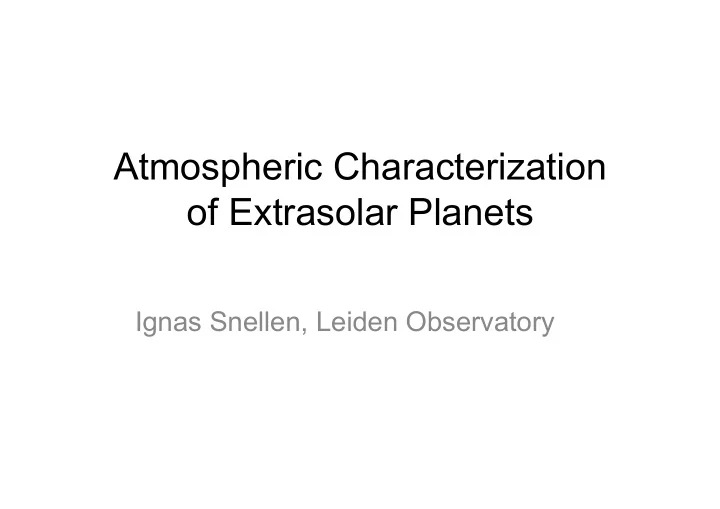

Atmospheric Characterization of Extrasolar Planets Ignas Snellen, Leiden Observatory
Why do we want to study exoplanet atmospheres? X We want to understand the atmospheres of all planets (?)
Why do we want to study exoplanet atmospheres? X We want to understand the atmospheres of all planets (?) X To understand the atmosphere of the Earth we need to understand the atmospheres of all planets (?)
Why do we want to study exoplanet atmospheres? X We want to understand the atmospheres of all planets (?) X To understand the atmosphere of the Earth we need to understand the atmospheres of all planets (?) V Understanding planet atmospheric processes and their evolutionary histories is crucial for unambiguously identifying biomarker gases
Understanding exoplanet atmospheres an enormous challenge: Solar system planets show immense complexity and diversity Gas giants : H2-dominated; clouds; strong zonal flows; storms Rocky planets : very diverse
Understanding exoplanet atmospheres an enormous challenge: Solar system planets show immense complexity and diversity Rocky planets : secondary atmospheres -- very diverse Super-rotating, Partially clear, Tenuous CO2 CO2 based N2-based Varying trace-amount of Opaque sulfuric acid clouds Biotic oxygen methane
Current Status: “Trying to comprehend Darwinian evolution using three animals”
First impressions from exoplanet population: even more diversity! • Hot Jupiters • Super-Earths – mini-Neptunes • Gas giants at large orbital distances • Requirement: study large samples, including all planet types from gas giants to rocky planets, in a wide range of orbits around stars varying in mass, metallicity, and age.
Exoplanet challenge You visit You dig and drill in situ measurements Understanding planets • Body’s mass, size Exoplanets • Composition of atmosphere, surface Possible • Rotation period, oblateness hard • Gravity field, magnetic field too difficult? • Seismic data Impossible! • Laboratory data � behaviour of materials • Quantum mechanical calculations
Atmospheric Characterization Understanding the 3D climate � absorbed stellar flux, reradiated back in space, intrinsic heat � T/p profile, set by stellar incident energy, abundances of spectroscopically active molecules, hazes/clouds � Rotation and atmospheric circulation
Studying exoplanet atmospheres It’s all about separating the planet from the star! Filtering Observing Technique Time domain Transits, eclipses, phase curves Spatial domain High Contrast Imaging (HCI) Spectral+Temporal High Dispersion Spectroscopy (HDS) Spectral+Spatial domain HDS+HCI
Temporal separation transmission spectroscopy eclipse spectroscopy
Temporal separation HD 189733b - Pont et al. 2012 Cloud deck? Deming et al. 2013 Stevenson et al. 2014
Time domain: pushing towards smaller planets � super-Earth regime GJ1214: Kreidberg et al. 2014
James Webb Space-based Time Domain: Nikolay Nikolov talk Ashlee Wilkins talk David Ehrenreich Talk
Using Time Domain is challenging from the ground Measure <10 -3-4 variations in flux as function of λ over 1-5 hour time scales Transits and Secondary Eclipses Earth Atmosphere: o Variations in turbulence / seeing o Variations in absorption & scattering o Variations in thermal sky emission Instrumental: o Variations in gravity vector or field rotation o Variations in thermal behaviour
Using Time Domain is challenging from the ground Measure <10 -3-4 variations in flux as function of λ over 1-5 hour time scales Transits and Secondary Eclipses Observe target + reference stars simultaneously Atmospheric variations similar for target & refs o Different optical paths through telescope + instruments o Bean et al., Nature 2010 GJ1214b Talks: Louden, Lendl Poster on FORS2 by Boffin
Spatial Separation � High Contrast Imaging young, self-luminous planets: SPHERE, GPI & Subaru are state-of-the-art Adaptive Optics - Planet flux � D 2 Coronagraphy - resolution � D -1 Smart algorithms - background � Constant - cooler planets brighter longer wavelengths Talks yesterday! Quanz et al. 2013
Top METIS Science Case High Contrast Imaging (HCI) Planets are ubiquitous � target the nearest stars Evolved planets have cooled down wavelengths
Spectral + Temporal Separation � HDS Hot Jupiters: CRIRES is state-of-the-art Talks by: A Wyttenbach Jayne Birkby J. Martins Emanuele di Gloria (using the chromatic RM effect)
CRIRES+: probing above the cloud deck HDS probes the atmosphere at lower pressures than low-res spectroscopy
Spectral + Spatial Domain: HDS + HCI Talk by Henriette Schwarz Beta Pictoris b
Top METIS Science Case HDS + HCI Atmospheric characterization of nearby rocky planets METIS IFU Snellen et al. 2015
A5 3 M s G2 1 M s y t i c o l e V l a i d a R M2 0.3 M s Transit M5 0.1 M s 0.1 AU 0.3AU 1 AU 3 AU Orbit
A5 3 M s G2 1 M s y t i c o l e V l a i d a R M2 0.3 M s Transit M5 0.1 M s 0.1 AU 0.3AU 1 AU 3 AU Orbit
Great Future Ahead! • Time Domain: transits and eclipses JWST � let’s get organized! • Spatial Domain: High Contrast Imaging SPHERE, GPI, Subaru JWST METIS@ELT, EPICS… • Spectral + Time Domain: High Dispersion Spectroscopy ESPRESSO and CRIRES+ E-ELT: METIS and HIRES • Spectral + Spatial Domain: HDS + HCI CRIRES+ E-ELT: METIS (and HIRES?) Ian Crossfield’s talk
Recommend
More recommend